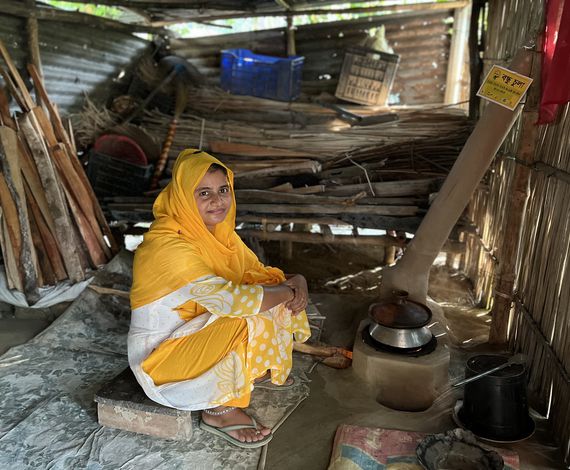There are many ways to live a lower carbon lifestyle, and every one of them has a real impact on tackling climate change. Below are some recommendations to get you started on reducing your carbon footprint.
Avoid overwhelming yourself with drastic changes. It’s best to view this process like you would if you were adopting healthy eating instead of going on a crash diet. So do one thing new each week or each month and see your carbon footprint shrink over time.
How to reduce your carbon footprint at home
Heating conservation
- Draughts waste a lot of energy by losing heat. One quick and relatively cheap win is to put a brush or seal on your doors to prevent air escaping round the edges. Letterboxes and keyholes also lose heat and can be covered too. Gaps in floorboards and skirting boards also let in draughts; you can fill in these gaps with newspaper, beading or sealant.
- Stick aluminium foil or reflective panels behind radiators. This reflects heat back into the room rather than being absorbed into walls.
- In winter close your curtains at night to stop heat escaping.
- Make sure your loft has loads of insulation. It’s one of the cheapest and easiest ways to save energy and will pay for itself in hardly any time.
- Consider insulating your cavity walls. If you live in an older house, which has no cavities, consider asking a builder to put insulating plaster board on the interior of outside walls. Builders may also be able to put insulating layers on your walls from the outside.
- Why not contact your local low carbon group – they may have a thermal imaging camera to you can make arrangements with them to photograph your house on a cold night and see where the hotspots are.
- You can reduce 50% of your heat loss through windows by installing double glazing, which in turn could cut your heating bill up to £90 a year. Make sure they are properly installed though, as gaps around the outside will lose heat. (Visit the Energy Saving Trust for more details)
- Turn your thermostat down to 18°C and put on an extra jumper.
Electricity conservation
- Switch to a renewable electricity supplier
- Buy A-rated electrical appliances.
- Switch to energy saving light bulbs, when your old bulbs break. They last around 10 times longer than ordinary light bulbs; they will save you money and come in loads of different styles.
- Items left on standby can use up to 85% of the energy they would use if fully switched on. Turn them off at the wall – it doesn’t take long.
- Electric tumble dryers use a huge amount of energy. If it’s a nice day dry your clothes outside or even inside if it’s not so nice.
- When using a washing machine ensure there is a full load and turn down the temperature.
- If you have lights in your garden use solar powered lights that charge during the day and don’t require electricity.
- Take your phone charger out of the wall. It uses energy even when it’s not charging your phone.
Water
- If your heating system still has a tank, make sure it’s insulated with a thick jacket. It will save you lots of money not to mention reducing emissions.
- A dripping tap can be not only annoying but if it is a hot tap it can cost you in both water costs and water heating costs. Remember, water also has a carbon footprint associated with it from processing.
- Always use the correct size saucepan, and when heating water only use the amount you need.
- When making a cup of tea, only boil the amount of water that you need.
- Turn off the tap while cleaning your teeth.
- If your toilet cistern holds more than 6 litres of water (likely if it was installed before 2001) put a Hippo Water Saving device in it.
- Have a shower instead of a bath, which uses far less energy and water. Although beware – power showers can use more water. Which? have a number of water saving suggestions for shower users.
Food and the fridge
- The location of your fridge can make a difference in how energy efficient it is. Make sure it is out of direct sunlight and not close to the oven. Keeping it against an outside wall will help the heat it generates escape easily, and always make sure that there is a few inches’ space all around the fridge so that air can circulate.
- Make sure you defrost your fridge and freezer on a regular basis.
- Only set your fridge to as cold as you need it and avoid keeping the door open for long periods of time as the more cold air that escapes, the harder the fridge has to work. You should check the seal regularly as well, if it is damaged then cold air will be escaping.
- You should never put warm or hot food into the fridge as this will make the fridge work extra hard to try and keep it cold; always allow food to cool down first.
- Defrost frozen food in the fridge as this helps to keep it cool as it thaws.
- Buy locally produced organic food.
- Eat less meat; producing 1 calorie of meat requires a lot more land and energy, compared to 1 calorie of vegetables.
Driving tips to lower your carbon footprint
Cars are generally very energy inefficient and travelling by train, bus or bike is much better for the planet. If you can’t manage without a car, changing your driving habits can help reduce its greenhouse emissions. Find out how much your car produces with our carbon calculator, measuring is the first step in reducing carbon footprints.
- Anticipate road conditions and drive smoothly, avoiding sharp acceleration and heavy braking. This saves fuel and reduces accident rates.
- Plan your journeys to avoid congestion, road works and getting lost.
- Drive away immediately when starting from cold – idling to heat the engine wastes fuel and causes rapid engine wear.
- Some newer cars tell you when to change gear, however if you are driving an older vehicle, check your revs – change up before 2,500rpm (petrol) and 2,000rpm (diesel).
- The most efficient speed depends upon the car in question but is typically around 55 – 65mph. Faster speed will greatly increase your fuel consumption.
- Check your tyre pressures regularly – under-inflated tyres are dangerous and can increase fuel consumption by up to 3%.
- If you’re stuck in a jam, switch the engine off if you expect to be there for more than a minute or two. Cutting the engine will save fuel and reduce emissions.
- Use air conditioning sparingly as it significantly increases fuel consumption.
- Avoid short journeys – a cold engine uses almost twice as much fuel and catalytic converters can take five miles to become effective. Cycle or walk instead.
- Accessories such as roof racks, bike carriers, and roof boxes significantly affect your car’s aerodynamics and reduce fuel efficiency, so remember to remove them when not in use.
- The heavier the content of your car, the more fuel it requires to move it. Keep your boot clear of heavy objects where possible.
- Get your car serviced regularly to keep it running efficiently.
Flying
We realise that sometimes people have no choice but to fly but the best thing for the planet is if you don’t fly at all, the resulting emissions can often represent the biggest chunk of your carbon footprint. Many short haul flights can be replaced by other forms of public transport such as trains or buses. Some of the ideas below are worth considering to help further carbon footprint reduction. In the meantime, if you have to fly you can offset your flight using our carbon calculator.
- If you are feeling adventurous and have the time there are many options for travelling long haul without flying. There are many websites available offering advice on how to travel all over the world without flying.
- When you have to fly, always consider if you can combine trips.
- It’s best to fly direct rather than stopping over, aeroplanes use a lot of fuel taking off and landing.
Ideas to reduce your carbon footprint at the office
A lot of the things you can do are the same as you would do in your home, but if you are feeling adventurous, you can always have a go at persuading your boss to go green and get your workplace reducing it's carbon footprint as well! Why not point them in the direction of our small business calculator or even our carbon neutral certification for those organisation's with larger carbon footprints.
- Only use the lights you need. Turn off lights in unused rooms. Better still; get your building to install occupancy sensors.
- Turn off your computer monitor when you leave the office at the end of the day.
- Do you really need those hard copies, or can you save it on your computer instead?
- Think before you print – but if you have to print at all, print double-sided – you can even print multiple pages to a sheet.
- Open up – if you have windows you can open, use them to intelligently save energy.
- Can you share a lift to get to work?
- Ask if you company is signed up to the cycle to work scheme. If not, they can find details on the government’s website. You could also ask if your company will install showers on site.
- Perhaps see if you can teleconference and work from home occasionally.
Links to other websites
There are a great many sites offering advice on reducing emissions. Here are just a few you could visit*:
UK government
The UK government provides advice on emission reductions and statistics on an international and domestic level. They also explore the challenges and obstacles that can delay action.
EST
The Energy Saving Trust provides valuable recommendations on how we can all help fight climate change and become more efficient with our use of energy.
http://www.energysavingtrust.org.uk/
Sustrans
Cycling is a fantastic way to get around cities, with more and more safe cycle routes available and advice to be found on using bicycles as your primary mode of transport. Sustrans provides sustainable transport advice for the whole of the UK, much of which is applicable worldwide:
The Soil Association
The Soil Association offers “a taste of the good life” on their website, giving tips on how to revive the rustic and rudimentary joys of life.
http://www.soilassociation.org/
Travel
Taking the train can be a quick and cheap way to travel within and around Europe. Book early to avoid disappointment.
*Climate Impact Partners is not responsible for the content of third-party websites.
There are many ways to live a lower carbon lifestyle, and every one of them has a real impact on tackling climate change.
100+ million tonnes of emissions have been reduced by Climate Impact Partners
Further Insights
Dernières actualités

UK Government Launches Voluntary Carbon and Nature Markets Consultation
Climate Impact Partners comments on the launch of the UK Government's consultation on raising integrity in Voluntary Carbon and Nature Markets.
Pour en savoir plus
Groundbreaking AI platform launched to deliver real-time, personalised climate policy insights to corporates
Supported by Climate Impact Partners and with investor funding, Maiven, a new AI platform, provides personalised, real-time climate policy insights.
Pour en savoir plus
Climate Impact Partners Comments on SBTi's Corporate Net-Zero Standard V2
Climate Impact Partners' CEO, Sheri Hickok, shares views on SBTi's draft Corporate Net-Zero Standard V2, now open for consultation.
Pour en savoir plus












